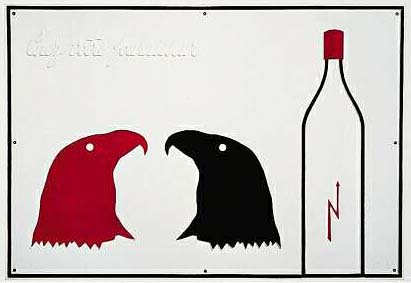Conceptual Art (1965-1975)
dal 19/4/2002 al 23/6/2002
Segnalato da
Lawrence Weiner
Bruce Nauman
Carl Andre
Gilbert and George
Joseph Kosuth
Sol Lewitt
Marcel Broodthaers
Buren
Job Koelewijn
Jan Dibbets
Ger van Elk
Marinus Boezem
Rudi Fuchs
Camiel van Winkel
Carel Blotkamp
Hripsime Visser
Margriet Schavemaker
Marga Bijvoet
Kitty Zijlmans
Jeroen Boomgaard
19/4/2002
Conceptual Art (1965-1975)
Stedelijk Museum, Amsterdam
Many contemporary artists prefer a focus on processes, social interaction and communication to a focus on the material interpretation of their ideas and concepts. In this sense their work is related to the conceptual art of the sixties and seventies. This relationship to and the growing interest in the art of thirty years ago, prompted the Stedelijk Museum to an overview of conceptual art between 1965 and 1975, an overview in which the relationship to the Dutch language area is central.

Between 1965 and 1975 there was an international
network of well-known and lesser known conceptually --
oriented artists, whose work and actions have been
important to and characteristic of this art movement. The
works shown at the Stedelijk exhibition were taken from
Dutch and Belgian public and private collections and
occupy all the rooms on the ground floor and the print
gallery. For the first time the conceptual art developments
in the Netherlands of the 1965-1975 period will be put in a
context. A context in which attention will be paid not only
to the role of our country as a meeting place for Dutch,
European and American conceptual artists, but also to the
important contribution to its dissemination and support,
made by galleries, museums and private collectors in the
Netherlands and Belgium. Some Dutch artists, such as Jan
Dibbets, Ger van Elk and Marinus Boezem, played a
decisive role, as did the exhibitions organised by Wim
Beeren in the Netherlands at the time, e.g. the 1969
Stedelijk exhibition 'Op losse schroeven' (Everything is
unsettled) and 'Sonsbeek buiten de perken' (Sonsbeek park
unlimited) of 1971. A work typical of the Stedelijk
exhibition was Boezem's ephemeral action, where white
sheets were hanging from the windows of the building, as
if the museum was hanging out its wash. The work is
characteristic of the associative spectrum of conceptual
art, and can be compared to the much more recent but
just as symbolical action of the Dutch artist Job Koelewijn,
who some years ago, had a number of Spakenburg women
in their traditional costumes clean the windows of the
Amsterdam Rietveld Academy pavilion.
The present Stedelijk exhibition shows only the conceptual
artists of this famous 'first 'generation. The large
difference in country of origin and background of the
conceptual artists who created a furore here and the large
amount of attention paid to the individual expression make
it virtually impossible to give a sound conceptual art
definition, although some artists, including Joseph Kosuth,
Lawrence Weiner and Sol Lewitt have tried (The idea
itself, even if not made visual, is as much a work of art as
any finished product'' - Lewitt). It is certainly true that is
it not the made forms or the matter, but the ideas, the
intentions - the concept - that are central. One of the
most important features of conceptual art is its often little
material character. At the Stedelijk exhibition many photos
and videoworks will be shown, in addition, of course, to
documents, notes, textworks and installations. Text, which
in conceptual art can be very visual and associative, will -
naturally - be one of the central elements in this
exhibition. Conceptual art responds to the typical urge of
the sixties for a completely different way of presenting,
examples of which also include Land Art, Arte Povera and
performance art.
The first stage of conceptual art, the 'creative' stage, was
mainly oriented towards the idea and the experiment, while
later on the emphasis on materialising the concept was
more dominant; the 'productive' stage.
One of the exhibition elements is a reconstruction of a
textwork that Lawrence Weiner once made for the
Stedelijk. The colour scheme which Buren made for the
arches in the Stedelijk hall in 1983, will be reintroduced as
well. Neonworks by Nauman will be shown, as will be all
Lewitt's original notes about conceptual art, his 'Map of
Amsterdam without the Amstel River', Andre's' poems, On
Kawara's 126-part, picture postcard 'I got up' and Gilbert
and George's videowork 'Gordon's makes us Drunk'. In all,
the exhibition will show 281 works, including Marcel
Broodthaers 'L'Entree de l'exposition' installation from the
Maastricht Bonnefantenmuseum - how extraordinary to see
this work in the exclusive context of its time.
At the exhibition and in the accompanying catalogue - to
be published in co-operation with NAI publishers -
documentation material and a time bar will be used to add
a broader social/cultural perspective to the conceptual art
developments. Rudi Fuchs, Camiel van Winkel and Carel
Blotkamp will make a contribution to this catalogue (Dutch
and English edition, ISBN 90-5662- 247-3/1).
In co-operation with Amsterdam University a symposium
will be organised on 24 May 2002. The (conditional) list of
speakers includes: Hripsime Visser, Margriet Schavemaker,
Marga Bijvoet, Kitty Zijlmans and Jeroen Boomgaard.
Stedelijk Museum Amsterdam
Paulus Potterstraat 13 1070 AB Amsterdam, The Netherlands
Hours: open daily 11.00 am - 5.00 pm



